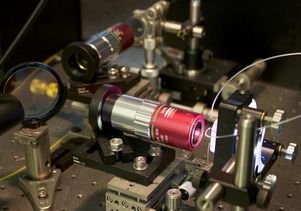Artificial Intelligence Helps Find Cancer Cells
A microscope, invented by a professor at the University of California, uses artificial intelligence in order to locate cancer cells more efficiently than ever before. The device uses photonic time stretch and deep learning to analyze 36 million images every second without damaging the blood samples. This new technique for identifying problematic cells is faster and more accurate than standard methods currently in practice.
Commonly, doctors will add biochemicals to blood samples in order to check for cells containing cancer. The biochemicals attach what scientists call "biological labels" to damaged cells, which enables instruments to both locate and identify differences. These tests have proven problematic, as the biochemicals used would often damage cells, making them unusable for future testing. Other techniques currently in practice do not label cells, but identify cancer cells based on physical characteristics that can oftentimes falsely identify regular cells as damaged.

Photonic time stretch microscope
(Image Credit: Tunde Akinloye/CNSI)
The photonic time stretch microscope images cells without causing them harm and can identify over two dozen physical characteristics, including: biomass, granularity and size. This alone makes for much more accurate and effective identification of the correct cells and makes retesting an option that wasn't always available in the past. These new tests invented at UCLA use a photonic time stretch microscope, a practice capable of imaging cells in blood samples very quickly. Couple that with a deep learning computer program that locates cancer cells correctly 95% of the time, and you have a much better chance of pinpointing cancer cells early on, allowing for quicker treatment to stop the spread. Deep learning is a popularly used artificial intelligence that works with complex algorithms to pull meaning from data, leading to better decision making.
The most recent studies lead by Barham Jalali, professor and Northrop-Grumman Optoelectronics Chair in electrical engineering; Claire Lifan Chen, a UCLA doctoral student; and Ata Mahjoubfar, a UCLA postdoctoral student were published in the journal, Nature Scientific Reports. Jalali invented photonic time stretch. This new technology can prove to be helpful in many different scientific applications. For now, the main focus is its ability to take pictures of blood cells with the help of flashing lasers. The lasers can be compared to the flash of a camera and occur in a matter of nanoseconds, something normal instrumentation would not be able to digitize. With the help of optics that boost clarity within images while at the same time slowing them down just enough to detect and capture at a rate of 36 million images each second, the new microscope can track information not possible in the past. The deep learning function then distinguishes the difference between healthy and cancer riddled white blood cells.
Mahjoubfar says each frame is slowed down in real time and then amplified on an optical level so the data can be rapidly digitized. This lets scientists perform fast cell imaging that artificial intelligence is then able to classify. Chen states the photonic time stretch approach allows researchers to identify rogue cells in a very short period of time even with low levels of illumination.
UCLA researchers added in their latest paper that the system could expedite the availability of new treatments for disease because of their data-driven diagnoses. Physical characteristics of cells would help reach cancer diagnoses much faster than ever before. This new technology will also lead to a better understanding of tumor specific genes within cells.
Like what you read (without annoying ads :) ) ? Then please upvote our posts and follow us for the best daily science news on SteemIt!


Hi! I am a content-detection robot. This post is to help manual curators; I have NOT flagged you.
Here is similar content:
http://sciencenewsjournal.com/artificial-intelligence-helps-find-cancer-cells/
@cheetah and @anyx didn't you whitelist us already? :) Yes, this is our content that is also on our website...
I recently refreshed the whitelist.
The new purpose is only for cross posts (e.g articles posted the same day in multiple locations), and both articles must contain a link to each other.
If you can be sure to do this for the post and future posts, I can go ahead and whitelist you again. :)
I don't quite understand what you mean. We don't post the same article on the same day both on our site and here. We usually post it on steem one later to avoid any duplicate content problems... Does that work for you or what do you need?
Not sure what's confusing, this post is from April, it is old.
And neither a) the post on the website or b) the post on steemit contains a link to the other.
@anyx So we need to add a link here to our site and on our site to here? Sorry but we won't be doing that because that is like doing a two way link exchange for SEO and that is what gets you a penalty on Google.
We can put a source link inside each of our steem posts but we won't be linking to them from our website. Does that work for you?
Being an Iranian myself, I couldn't help but notice that two of the researchers named in this article are Iranian: Prof. Bahram Jalali and Ata Mahjoubfar.